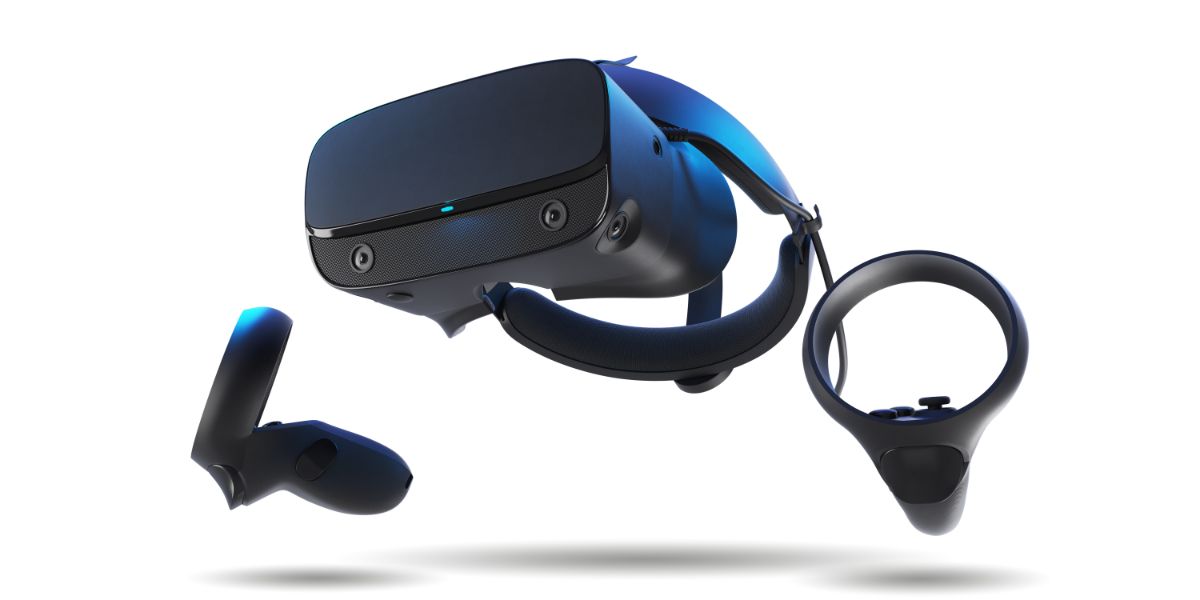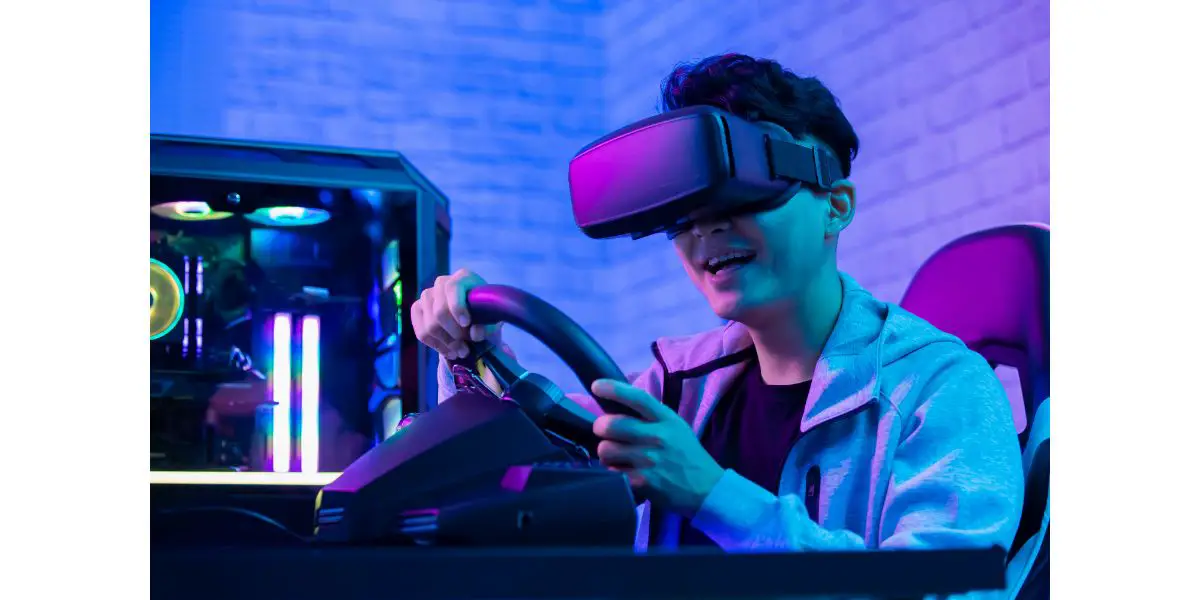Disclaimer: This post may contain affiliate links, meaning we get a small commission if you make a purchase through our links, at no cost to you. For more information, please visit our Disclaimer Page.
Video games across different platforms are popular right now, and virtual reality is one of the next logical steps in this industry. With most conventional video games, you’ll control a character on a separate display. In doing so, you’ll use some interface device to input actions that happen in the game.
You’ll most of the time watch the story and actions play out on a television screen or computer monitor. The input devices you use will have wired or wireless connections to the computer or gaming console on which you play your favorite titles.
In contrast, virtual reality simulations attempt to make it feel as though you are right in the middle of all the action. These platforms will still use some input devices to help you move through the game world. However, instead of the typical screens with which you might be familiar by now, a VR title will use goggles, a headset, or similar technology to make the whole experience more immersive.
Some VR games can accomplish this already, but the graphics may still leave much to be desired, particularly when comparing them to conventional games. We’ll discuss the possible reasons for this in today’s post.
Table of Contents
Why Are VR Game Graphics Bad?
How bad you might think virtual reality graphics look can certainly be relative, but there are some objective markers we can use to put a traditional console or computer games up against some of the VR titles. When you think of some of the most advanced games you can play today, you might think of titles with very high frames per second, textures that render in high resolutions, and monitors that can display everything in crisp detail with thousands of pixels. Some games today might even look realistic enough to rival the computer-generated cutscenes of their predecessors.
Much of this level of detail will depend on the kind of hardware you’re running, but you can put many games against most of today’s virtual reality titles to see a stark difference in how the graphics look in each one.
While a select few VR games look good enough to rival some of their contemporary counterparts, most will not display in resolutions that are close to what you can get on a good console or modern computer. Some gamers wonder why this is so, especially since we have the technology to render immersive virtual environments today.
The simple answer is that, as far as virtual reality has come in recent years, it is still in its infancy when compared to other video technologies. It is fair to think of virtual reality as another way to enjoy video games or films, but this isn’t the whole truth. While VR is another type of gaming, it also operates on an almost entirely different level. This means it has quite a few extra requirements that your traditional consoles or computers do not have.
More or different requirements would also mean that the technology’s development will be different, and things may take longer for VR platforms as we further refine this tech. The various development paths companies take here could mean the costs will differ. Although you may think the latest console or computer is expensive, more work needs to go into virtual reality game development to deliver a product that is worthy of VR.
When you couple this fact with the need to keep putting resources into furthering virtual reality development, the cost tends to be higher than it would be for other forms of gaming. In turn, developers must keep those costs reasonable as they create games. Therefore, the limitations of the working budget and the technology itself are two big factors that play a role in how VR graphics look today.
Before we move on, it is worth noting that some virtual reality titles can look quite good. As mentioned, this can depend on the hardware you are running to play the games. If you are coupling your VR technology with the latest desktop computer you’ve designed from the ground up, you may find some games you can play in the virtual world that seem quite advanced. There are still some limitations here, and we will discuss them in further sections.
Why Are VR Videos in Low Resolution?
Many gamers are used to playing titles on high-end computer rigs or the latest generations of their preferred consoles. As such, they usually have hardware that can run these titles at high resolutions with good graphics. When they make the jump into VR, they might see that the environments the games can render seem to be at much lower resolutions, almost as though they are playing games from a decade ago or more.
Many virtual reality games you can play today look like their resolutions are low based on what the developers are trying to do within the constraints of the available technology. We can break this down into further sections that help to illustrate this point.
1. A Complete View
To put the player in the game world as much as possible, virtual titles try to create a 360-degree view of the world. As they do this, most games will try to cover the entirety of the vertical view that you should have available to you at any given time. That is to say, the game will try to render its graphics completely from the top of your viewer to the bottom.
When the hardware does this, it stretches the view over 180 degrees. With most goggles or headsets today, the player can probably only see about half of that total view at once, further cutting things down to about 90 degrees of usable display. In other words, you only see half of the frame at once.
2. Stereo Viewing
One of the principles of VR technology is letting you see the game environment as though you are in it. This is why goggles or headsets are the primary means gamers experience these kinds of worlds. However, doing this with the current technology means that the complete resolution of a stream splits itself into a stereo view.
This means that each eye of the goggle will get only part of the stream’s resolution. For example, a typical stream of 1080p will only be half of that in VR. You’ll get about 540p as an effective resolution. This display cuts down further when you factor in the view degree range we spoke of earlier. A 1080p virtual stream’s effective resolution becomes about 270p or so. Other common resolutions may convert 1440p to 360p or 4k to 540p.
3. Costs
A studio’s budget can influence the two above factors in major ways. Because virtual reality needs to work much harder than conventional gaming to achieve the immersion level players expect, the costs of most titles in this subcategory will be higher.
Some developers may need to keep games at low resolutions to be able to finish the products they would like to bring to the market. As technology improves and streamlines, we may see some studios able to put out games in higher resolutions for more affordable prices.
How Do I Make My Computer VR Videos Look Better?
Aside from having the absolute latest hardware to run a virtual environment, there might be a few things you can do to make the videos you run on your computer look nicer.
- Check your operating system to ensure it is running its most current version.
- If you’re already running a pretty advanced graphics card, ensure that its drivers and firmware are the latest versions from the manufacturer.
- A solid-state drive is probably the best one to use for VR gaming, but some hard disks can work well too. If you use an HDD, defragment it before running any VR programs.
- For any SSDs, run TRIM to achieve results similar to an HDD defragmentation.
- Change your computer’s power plan to send energy where it needs to be for high-end gaming.
- Use utility apps to further optimize how your computer handles graphics.
Will a Better Graphics Card Improve VR?
Yes, a better graphics card may improve your virtual reality experience. If you merge a VR headset with your PC, the computer’s graphics card can impact how crisp things look for you in the environment.
A good card can give you higher resolutions, smooth out the framerates, and ensure things don’t get too hot while you’re playing. Making sure the frames are high is of particular importance when it comes to VR gaming. Lower rates can cause a less immersive experience or physically negative effects.
Is VR Technology Improving?
Virtual technology is improving, although it may be hard to pinpoint precisely when the industry might achieve particular milestones. We know that certain virtual platforms that create more immersive conferencing environments for work have seen massive upticks in the number of users taking advantage of their services.
Additionally, predictions for the future of virtual reality for commercial use alone say that the value of the tech should increase to over 4 billion dollars as soon as 2023. This also has implications for the entertainment sector, with some telecommunications companies speculating that gamers should be able to engage all five senses in a virtual world at some point, possibly by 2030.
Conclusion
Virtual reality has changed the landscape of both entertainment and everyday business. The graphics we might be able to enjoy through this technology still have some ways to go, but the industry continues to work on advances in VR that should provide some improvements in the coming years. For now, you can optimize your virtual experience using some of the latest computer hardware and our tips above.


